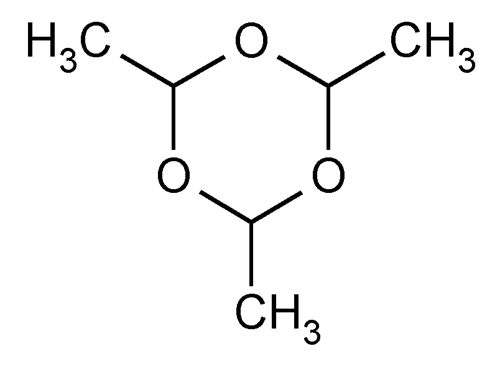Paraldehyde
» note—Paraldehyde is subject to oxidation to form acetic acid. It may contain a suitable stabilizer.
Packaging and storage—
Preserve in well-filled, tight, light-resistant containers, preferably of Type I or Type II glass, holding not more than 30 mL, at a temperature not exceeding 25 . Paraldehyde may be shipped in bulk containers holding a minimum of 22.5 kg (50 lb) to commercial drug repackagers only.
. Paraldehyde may be shipped in bulk containers holding a minimum of 22.5 kg (50 lb) to commercial drug repackagers only.
Labeling—
The label of all containers of Paraldehyde, including those dispensed by the pharmacist, includes a statement directing the user to discard the unused contents of any container that has been opened for more than 24 hours.
note—The label of bulk containers of Paraldehyde directs the commercial drug repackager to demonstrate compliance with the USP purity tests for Paraldehyde immediately prior to repackaging, and not to repackage from a container that has been opened longer than 24 hours.
Identification—
Heat it with a small quantity of 2 N sulfuric acid: acetaldehyde, recognizable by its pungent odor, is produced.
Congealing temperature  651
651 :
not lower than 11
:
not lower than 11 .
.
Distilling range, Method I  721
721 —
It distills completely between 120
—
It distills completely between 120 and 126
and 126 , a correction factor of 0.050
, a correction factor of 0.050 per mm being applied as necessary.
per mm being applied as necessary.
Acidity—
To a solution of 6.0 mL in 100 mL of water add 5 drops of phenolphthalein TS, and titrate with 1.0 N sodium hydroxide: not more than 0.50 mL is required to produce a pink color (0.5% as acetic acid).
Chloride—
To 5 mL of a solution (1 in 10) add 1 drop of nitric acid and 3 drops of silver nitrate TS: no opalescence is produced immediately.
Sulfate—
To 5 mL of a solution (1 in 10) add 1 drop of hydrochloric acid and 3 drops of barium chloride TS: no turbidity is produced.
Limit of nonvolatile residue—
Heat 5.0 mL in a small, tared evaporating dish on a steam bath: no disagreeable odor is noticeable as the last portions evaporate, and, when dried at 105 for 1 hour, not more than 3 mg of residue remains (0.06%).
for 1 hour, not more than 3 mg of residue remains (0.06%).
Limit of acetaldehyde—
Place 100 mL of water in a 250-mL conical flask, add 5.0 mL of Paraldehyde, and shake the mixture gently until solution is complete. Add 5 mL of hydroxylamine hydrochloride solution (3.5 in 100). Shake the mixture gently for 30 seconds, add methyl orange TS, and titrate immediately with 0.50 N sodium hydroxide. Perform a blank titration: the difference between the titers does not exceed 1 mL of 0.50 N sodium hydroxide (0.4%).
Auxiliary Information—
Please check for your question in the FAQs before contacting USP.
| Topic/Question | Contact | Expert Committee |
| Monograph | Ravi Ravichandran, Ph.D.
Senior Scientist 1-301-816-8330 |
(MDPP05) Monograph Development-Psychiatrics and Psychoactives |
USP32–NF27 Page 3207
